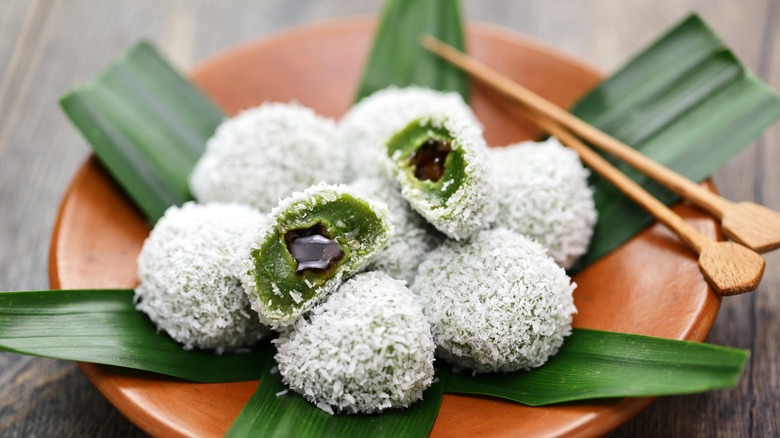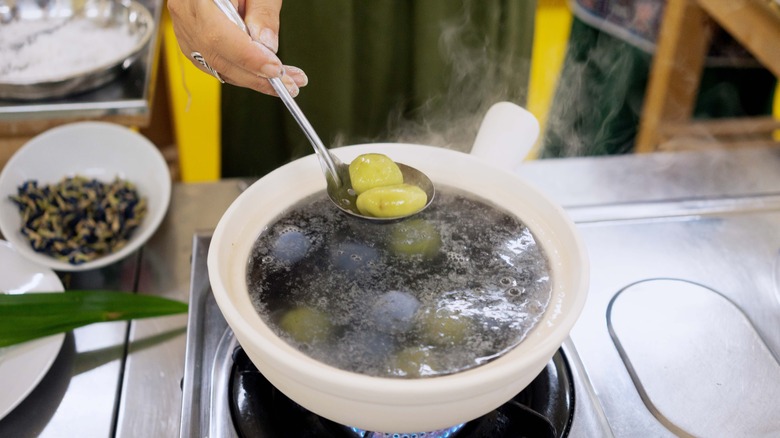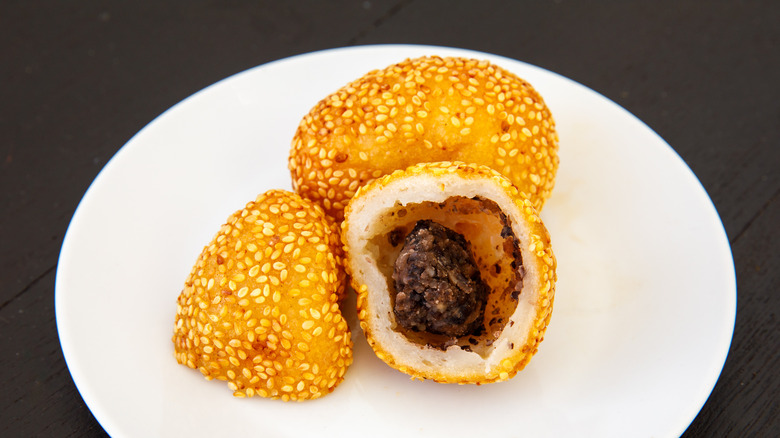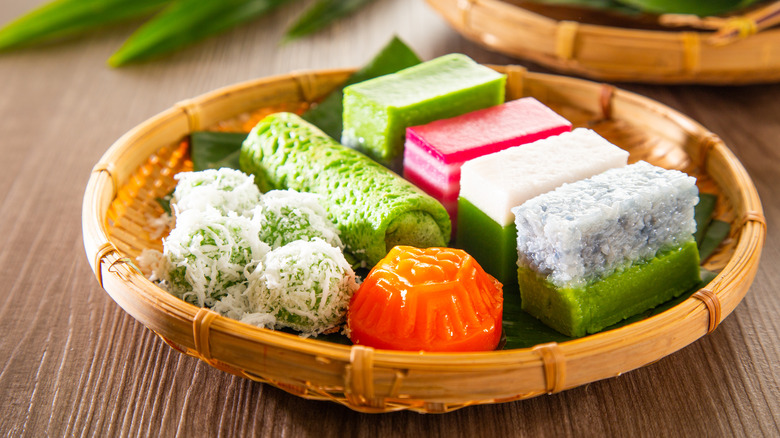Onde-Onde Is The Sweet Rice Cake With A Gooey Sugar Center
Desserts come in all colors, shapes, and sizes, but few culinary traditions showcase that full range quite like kuih. Hailing from Malaysia, this kaleidoscopic spread of sweets utilizes a range of techniques, ingredients, and presentations. While all delicious, one of them is a rice-based confection that especially stands out: Onde-Onde.
Made from glutinous rice powder, these sweet-tasting balls of dough are covered with coconut, infused with pandan, and filled with gula melaka, a type of palm sugar. The dessert has an invigoratingly explosive nature. With a bite, the sweet and gooey interior bursts, almost like a profiterole.
It is believed that Onde-Onde hail from Indonesia, named after the dessert's resemblance to fish balls. Later, it became a frequent component of Peranakan tradition — a culture that fuses Chinese, Malaysian, and Indonesian culinary techniques. Today, it's enjoyed in Indonesia, Malaysia, and Singapore, as well as Brunei, with variations in ingredients. Let's dive into how it's created.
How is Onde-Onde made?
Onde-Onde comes together with a deft assembly technique utilizing only a few components. First, the glutinous rice flour is combined with pandan juice; some recipes also include sugar. It's necessary to introduce heat to the mix, as the temperature aids in forming the dough. Some accomplish this by boiling a small portion of the dough and reintroducing it. Others heat the pandan juice before combining it with the flour. The mixture is then kneaded until smooth and rested for around 15 minutes. Meanwhile, the grated coconut is prepped for use. In order to make it soft for consumption, it's steamed for a few minutes with salt.
Once prepared for assembly, a large pot of water is brought to a boil. The dough is shaped into a flattened circular shape, utilizing approximately half an ounce at a time. The palm sugar is spooned into the center, and then the confection is rolled into a ball. Onde-Onde are boiled until they float to the top. It's crucial they're cooked as quickly as possible, because the longer the formed dough sits, the more likely it is to break apart. After the balls are retrieved from the water, they're coated in the coconut mixture and are ready to serve.
Variations of Onde-Onde
A simple recipe enjoyed across a large region, Onde-Onde comes in many forms. Some add tapioca flour to the mix, while others up the coconut flavor with milk. While pandan is a cornerstone flavor of the dessert, it's sometimes complemented with sweet potato. Another version forgoes the tropical plant completely, instead infusing the dough with butterfly pea extract.
In Indonesia, Onde-Onde also encompasses other sweet and sticky ball-shaped desserts. Versions include a ball made with sweet potato starch in addition to glutinous rice. The interior contains blended green beans, coconut milk, and vanilla. The entire creation is covered in sesame seeds, lending a similar textural experience but with a completely different palette. Such a variation of flavors only adds to the allure of the dessert; each one is represented by a distinct color and texture, adding to its kaleidoscopic nature. Plus, there's always another version to sample.
Where to eat Onde-Onde
Onde-Onde are often prepared in the home collaboratively, enjoyed as an activity that facilitates bonding time with family and friends. Especially since kuih recipes are passed down from one generation to the next, the dessert boasts a communal creation nature.
It can also be purchased at dedicated sweets shops and cafes. Kuih is sold in a variety of settings, ranging from street carts to large, established restaurants. It can be enjoyed on its own, alongside savory dishes, or with a cup of coffee. Since each creator puts their own unique take on the dish, going out for Onde-Onde is a fun experience that is rarely the same twice.
In Malaysia, Onde-Onde is easier to find in cities with a significant Peranakan population. The trading port of Malacca, in particular, is a noted hotspot. Other major hubs include Penang and Singapore, although you'll likely spot these delicious sweets in a host of other cities, too.



